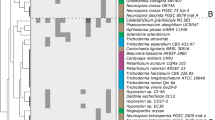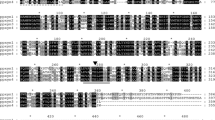Abstract
Many fungal plant pathogens secrete an array of cell wall degrading enzymes mainly involved in the pathogenesis. In this work, a cDNA clone encoding an extracellular endo-1,4-β-glucanase (named PlEGL1) from the causal agent of the Corky Root Rot of tomato, Pyrenochaeta lycopersici, was isolated and characterized, in order to understand its putative role in the pathogenesis and its mechanism of action. Multiple alignment of the deduced amino acidic sequence shows a high homology with other endoglucanases from different phytopathogenic fungi and detects a well-defined conserved domain of the Glycosyl Hydrolase family 61 (GH61). In vitro, Plegl1 gene transcription is correlated to a cellulolytic activity of the fungus, regulated, in its turn, by the presence of sugar and/or cellulose in the culture medium. In the infected plants, expression level of Plegl1 is positively correlated to the development of the disease. PlEGL1 was heterologously expressed in Escherichia coli and the recombinant protein was purified and tested for its cellulolytic ability, showing a very weak activity, in agreement with all the endoglucanases belonging to GH61 family. The finding in this paper will provide the basis for further determination of biochemical properties of the PlEGL1 protein and its possible involvement in the host–pathogen interaction.









Similar content being viewed by others
References
Aragona M, Infantino A (2008) Expression profiling of tomato response to Pyrenochaeta lycopersici infection. Acta Hortic 789:257–263
Bauer S, Vasu P, Persson S, Mort AJ, Somerville CR (2006) Development and application of a suite of polysaccharide-degrading enzymes for analyzing plant cell walls. Proc Natl Acad Sci USA 103:11417–11422
Benhamou N, Côté F (1992) Ultrastructure and cytochemistry of pectin and cellulose degradation in tobacco roots infected by Phytophthora parasitica var. nicotianae. Phytopathology 82:468–478
Bradford MM (1976) A rapid and sensitive method for quantitation of microgram quantities of protein utilizing the principle of protein–dye binding. Anal Biochem 72:248–254
Brunner PC, Keller N, McDonald BA (2009) Wheat domestication accelerated evolution and triggered positive selection in the β-xylosidase enzyme of Mycosphaerella graminicola. PLoS One 4:e7884
Campbell RN, Hall DH, Schweers VH (1982) Corky root of tomato in California caused by Pyrenochaeta lycopersici and control by soil fumigation. Plant Dis 66:657–661
Cenis JL (1992) Rapid extraction of fungal DNA for PCR amplification. Nucleic Acids Res 20:2380
Coleman JJ, Rounsley SD, Rodriguez-Carres M, Kuo A, Wasmann CC, Grimwood J, Schmutz J, Taga M, White GJ, Zhou S, Schwartz DC, Freitag M, Ma LJ, Danchin EG, Henrissat B, Coutinho PM, Nelson DR, Straney D, Napoli CA, Barker BM, Gribskov M, Rep M, Kroken S, Molnár I, Rensing C, Kennell JC, Zamora J, Farman ML, Selker EU, Salamov A, Shapiro H, Pangilinan J, Lindquist E, Lamers C, Grigoriev IV, Geiser DM, Covert SF, Temporini E, Vanetten HD (2009) The genome of Nectria haematococca: contribution of supernumerary chromosomes to gene expansion. PLoS Genetic 5(8):e1000618
Cooper RM (1983) The mechanisms and significance of enzymatic breakdown of host cell walls by parasites. In: Callow JA (ed) Biochemical plant pathology. Wiley, New York, pp 101–135
Coutinho PM, Henrisaat B (1999) Carbohydrate-active enzymes: an integrated database approach. In: Gilbert HJ, Davies GJ, Henrisaat B, Svensson B (eds) Recent advances in carbohydrate bioengineering. The Royal Society of Chemistry, Cambridge, pp 3–12
Ellwood SR, Liu Z, Symel RA, Lai Z, Hane JK, Keiper F, Moffat CS, Oliver RP, Friesen TL (2010) A first genome assembly of the barley fungal pathogen Pyrenophora teres f. teres. Genome Biol 11:R109
Foreman PK, Brown D, Dankmeyer L, Dean R, Diener S, unn-Coleman NS, Goedegebuur F, Houfek TD, England GJ, Kelley AS, Meerman HJ, Mitchell T, Mitchinson C, Olivares HA, Teunissen PJ, Yao J, Ward M (2003) Transcriptional regulation of biomass-degrading enzymes in the filamentous fungus Trichoderma reesei. J Biol Chem 278:31988–31997
Gerlach W, Schneider R (1964) Nachweis eines Pyrenochaeta-Stadiums bei Stammen des Korkwurzelerregers der Tomate. Phytopathologische Zeitschrift 50:262–269
Goodenough PW, Kempton RJ (1974) Regulation of the synthesis of an extracellular polygalacturonase by Pyrenochaeta lycopersici when grown in media with limited carbon source. Phytopathology 81:78–84
Goodenough PW, Kempton RJ (1976) The activity of cell wall degrading enzymes in tomato roots infected with Pyrenochaeta lycopersici and the effect of sugar concentrations in these roots on disease development. Physiol Plant Pathol 9:313–320
Goodenough PW, Kempton RJ, Maw GA (1976) Studies on the root rotting fungus Pyrenochaeta lycopersici: extracellular enzyme secretion by the fungus grown on cell wall material from susceptible and tolerant tomato plants. Physiol Plant Pathol 8:243–251
Gough CL, Dow JM, Barber CE, Daniels MJ (1988) Cloning of two endoglucanase genes of Xanthomonas campestris pv. campestris: analysis of the role of the major endoglucanase in pathogenesis. Mol Plant Microbe Interact 1:275–281
Harris PV, Welner D, McFarland KC, Re E, Navarro Poulsen JC, Brown K, Salbo R, Ding H, Vlasenko E, Merino S, Xu F, Cherry J, Larsen S, Lo Leggio L (2010) Stimulation of lignocellulosic biomass hydrolysis by proteins of glycoside hydrolase family 61: structure and function of a large, enigmatic family. Biochemistry 49:3305–3316
Hématy K, Cherk C, Somerville S (2009) Host pathogen warfare at the plant cell wall. Curr Opin Plant Biol 12:406–413
Hok S, Attard A, Keller H (2010) Getting the most from the host: how pathogens force plants to cooperate in disease. Mol Plant Microbe Interact 23:1253–1259
Hückelhoven R (2007) Cell wall-associated mechanisms of disease resistance and susceptibility. Annu Rev Phytopathol 45:101–127
Infantino A, Pucci N (2005) A PCR-based assay for the detection and identification of Pyrenochaeta lycopersici. Eur J Plant Pathol 112:337–347
Jeanmougin F, Thompson JD, Gouy M, Higgins DG, Gibson TJ (1998) Multiple sequence alignment with Clustal X. Trends Biochem Sci 23:403–405
Kamoun S (2006) A catalogue of the effector secretome of plant pathogenic oomycetes. Annu Rev Phytopathol 44:41–60
Karkehabadi S, Hansson H, Kim S, Piens K, Mitchinson C, Sandgren M (2008) The first structure of a glycoside hydrolase family 61 member, Cel61B from Hypocrea jecorina, at 1.6 Å resolution. J Mol Biol 383:144–154
Karlsson J, Saloheimo M, Siika-Aho M, Tenkanen M, Penttila M, Tjerneld F (2001) Homologous expression and characterization of Cel61A (EG IV) of Trichoderma reesei. Eur J Biochem 268:6498–6507
Kasana RC, Salwan R, Dhar H, Dutt S, Gulati A (2008) A rapid and easy method for the detection of microbial cellulases on agar plates using gram’s iodine. Curr Microbiol 57:503–507
Koseki T, Mese Y, Fushinobu S, Masaki K, Fujii T, Ito K, Shiono Y, Murayama T, Iefuji H (2008) Biochemical characterization of a glycoside hydrolase family 61 endoglucanase from Aspergillus kawachii. Appl Microbiol Biotechnol 77:1279–1285
Laemmli UK (1970) Cleavage of structural proteins during the assembly of the head of bacteriophage T4. Nature 227:680–685
Lipka V, Dittgen J, Bednarek P, Bhat R, Wiermer M, Stein M, Landtag J, Brandt W, Rosahl S, Scheel D, Llorente F, Molina A, Parker J, Somerville S, Schulze-Lefert P (2005) Pre- and postinvasion defenses both contribute to nonhost resistance in Arabidopsis. Science 310:1180–1183
Marcus L, Barash I, Sneh B, Koltin Y, Finkler A (1986) Purification and characterization of pectolytic enzymes produced by virulent and hypovirulent isolates of Rhizoctonia solani Kuhn. Physiol Mol Plant Pathol 29:325–336
Martinez D, Berka RM, Henrissat B, Saloheimo M, Arvas M, Baker SE, Chapman J, Chertkov O, Coutinho P, Cullen D, Danchin EG, Grigoriev IV, Harris P, Jackson M, Kubicek CP, Han CS, Ho I, Larrondo LF, de Leon A, Magnuson JK, Merino S, Misra M, Nelson B, Putnam N, Robbertse B, Salamov AA, Schmoll M, Terry A, Thayer N, Westerholm-Parvinen A, Schoch CL, Yao J, Barbote R, Nelson MA, Detter C, Bruce D, Kuske CR, Xie G, Richardson P, Rokhsar DS, Lucas SM, Rubin EM, Dunn-Coleman N, Ward M, Brettin TS (2008) Genome sequencing and analysis of the biomass degrading fungus Trichoderma reesei (syn. Hypocrea jecorina). Nat Biotechnol 26:553–560
Matta A (1976) Dannosità della Pyrenochaeta lycopersici nelle colture di pomodoro in serra della riviera ligure. Colture Protette 5:31–33
Münch S, Lingner U, Floss DS, Ludwig N, Sauer N, Deising HB (2008) The hemibiotrophic lifestyle of Colletotrichum species. J Plant Physiol 165:41–51
Nowrousian M, Stajich JE, Chu M, Engh I, Espagne E, Halliday K, Kamerewerd J, Kempken F, Knab B, Kuo HC, Osiewacz HD, Pöggeler S, Read ND, Seiler S, Smith KM, Zickler D, Kück U, Freitag (2010) De novo assembly of a 40 Mb eukaryotic genome from short sequence reads: Sordaria macrospora, a model organism for fungal morphogenesis. PLoS Genet 6(4):e1000891
O’Connell R, Herbert C, Seenivasaprasad S, Khatib M, Esquerrè-Tugayè MT, Dumas B (2004) A novel Arabidopsis–Colletotrichum pathosystem for the molecular dissection of plant-fungal interactions. Mol Plant Microbe Interact 17:272–282
Park J, Jin J, Lee Y, Kang S, Lee Y (2009) Rice blast fungus (Magnaporthe oryzae) infects Arabidopsis via a distinct mechanism from that required for the infection of rice. Plant Physiol 149:474–486
Rowe HC, Kliebenstein DJ (2007) Elevated genetic variation within virulence associated Botrytis cinerea polygalacturonase loci. Mol Plant Microbe Interact 20:1126–1137
Sambrook J, Russell DW (2001) Molecular cloning: a laboratory manual. Cold Spring Harbor Laboratory Press, Cold Spring Harbor
Sang-Jik L, Jocelyn KCR (2010) Mediation of the transition from biotrophy to necrotrophy in hemibiotrophic plant pathogens by secreted effector proteins. Plant Signal Behav 5:769–772
Smith GE, Summers MD (1980) The bidirectional transfer of DNA and RNA to nitrocellulose or diazobenzyloxymethyl-paper. Anal Biochem 109:123–129
Stukenbrock EH, McDonald BA (2009) Population genetics of fungal and oomycte effectors involved in gene-for-gene interactions. Mol Plant Microbe Interact 22:371–380
Vaaje-Kolstad G, Horn SJ, van Aalten DM, Synstad B, Eijsink VG (2005) The non-catalytic chitin-binding protein CBP21 from Serratia marcescens is essential for chitin degradation. J Biol Chem 280:28492–28497
Wang P, Nuss DL (1995) Induction of a Cryphonectria parasitica cellobiohydrolase I gene is suppressed by hypovirus infection and regulation by a G-protein-linked signaling pathway involved in fungal pathogenesis. Proc Natl Acad Sci USA 92:11529–11533
Workneh F, van Bruggen AHC, Drinkwater LE, Shennan C (1993) Variables associated with corky root and Phytophthora root rot of tomatoes in organic and conventional farms. Phytopathology 83:581–589
Acknowledgments
This work was performed within the framework of the project RESPAT: “Identificazione di geni implicati nella resistenza e nella patogenicità in interazioni tra piante d’interesse agrario e patogeni fungini, batterici e virali”.
Author information
Authors and Affiliations
Corresponding author
Additional information
Communicated by B. Cormack.
Rights and permissions
About this article
Cite this article
Valente, M.T., Infantino, A. & Aragona, M. Molecular and functional characterization of an endoglucanase in the phytopathogenic fungus Pyrenochaeta lycopersici . Curr Genet 57, 241–251 (2011). https://doi.org/10.1007/s00294-011-0343-5
Received:
Revised:
Accepted:
Published:
Issue Date:
DOI: https://doi.org/10.1007/s00294-011-0343-5




